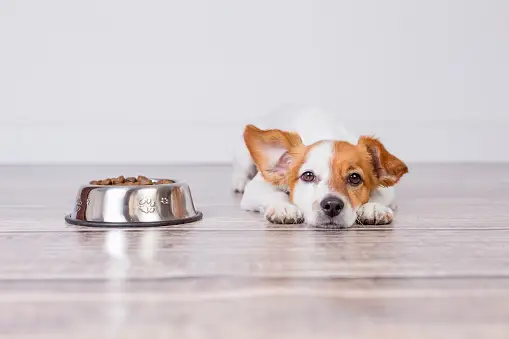Welcome to the dog owner’s essential guide on canine cuisine calamities. Just like a chocolate fountain is a hazard at a wedding for anyone wearing white, certain foods can be perilous to your pooch. In the spirit of keeping our tail-wagging friends in the pink of health, it’s crucial to understand what foods can dogs not eat. This isn’t about being the fun police; it’s about ensuring your dog’s wagging tail doesn’t come to a stiff halt. With the aim of this article being to serve up a comprehensive guide, you’ll be fully equipped to sidestep any dietary disasters.
Think of this as your map to navigate the minefield of munchies that can mess with your mutt’s wellbeing. Whether you’re a new dog owner or a seasoned pro, it’s always a doggone good idea to brush up on your knowledge of harmful foods for dogs. By the end of this guide, you’ll be as savvy about your dog’s diet as a top chef is about their ingredients. Let’s embark (pun intended) on this culinary quest for your canine’s sake!

Understanding Dog’s Nutritional Needs
Just like a snug sweater is a must-have for Fido during chilly walks, essential nutrients are the wardrobe of a healthy dog diet. These nutrients include a balanced mix of proteins, carbohydrates, fats, vitamins, and minerals. Feeding them human foods can be like trying to fit a Great Dane into a Chihuahua’s sweater – it just doesn’t work. Such foods may lack the crucial elements a pooch needs or, worse, cause harm. That’s why it’s imperative to have a chat with your local veterinarian to get the scoop on a tail-waggingly balanced diet. This helps ensure every meal is a step towards vibrant health, rather than a leap into the unknown. When it comes to our four-legged friends, it’s not just about filling the bowl, but about fulfilling their nutritional destiny.
Harmful Foods for Dogs: Grapes and Raisins
When it comes to snacking, our canine companions should steer clear of the vineyard’s bounty. Grapes and raisins may seem like a healthy treat for humans, but for dogs, they’re a big no-no. The exact cause of their toxicity in dogs remains a mystery to scientists, but the effects are clear and concerning. Even a small amount can lead to rapid kidney failure, with symptoms including vomiting, lethargy, and depression. So, it’s crucial to keep these fruity morsels out of paw’s reach. If you’re looking to reward your pooch with a juicy treat, consider dog-safe alternatives like sliced apples (sans seeds) or blueberries. These options are not just safe, but also packed with vitamins. Remember, when in doubt, consult your vet for the best snack suggestions.
Harmful Foods for Dogs: Chocolate
When it comes to treating ourselves, chocolate is a go-to indulgence, but for our canine friends, it’s a different story. Chocolate contains theobromine, a compound that is akin to caffeine and is a big no-no for pups. Dogs process theobromine much slower than humans, leading to potential theobromine poisoning. Depending on the type of chocolate and the size of your dog, even a small amount can be dangerous.
- Milk Chocolate: Less theobromine than dark chocolate, but still harmful in larger quantities.
- Dark Chocolate: Highly toxic to dogs due to a higher concentration of theobromine.
- Baking Chocolate: Contains the highest amount of theobromine and can be lethal even in small amounts.
Symptoms of chocolate toxicity in dogs include vomiting, diarrhea, rapid breathing, and seizures. The rule of thumb is simple: Keep the chocolate stash out of paw’s reach and ensure your dog’s snacks are canine-safe. Should your dog sneak a bite, consult your vet posthaste.
Harmful Foods for Dogs: Xylitol
As sweet as your pooch’s affection is, certain sweeteners certainly don’t reciprocate the love. Xylitol is the sweet-talking villain in this scenario, a common sugar substitute found lurking in many products, from sugar-free gum to toothpaste. If your dog eat food with this ingredient then it’s a big no-no. It can trigger a rapid release of insulin, leading to hypoglycemia (low blood sugar), which may result in loss of coordination, lethargy, and even seizures.
- Immediate Symptoms: Watch for vomiting, weakness, and difficulty standing.
- Grave Consequences: If left untreated, xylitol ingestion can lead to liver failure.
Instead of risking it with xylitol, opt for dog-specific treats or simply stick to vet-approved chews. Remember, your four-legged friend’s health is as precious as the adoring gaze they give you while you eat a cookie they can’t have.
Well, if you are also looking the point that dogs can eat cucumber, sugarcane & makhana you must read our other blogs
Other Foods to Avoid: Onions, Garlic, and Avocados
Imagine your kitchen as a treasure trove of delectable eats, but lurking among the culinary jewels are a few hidden gems that aren’t so pet-friendly. Specifically, onions, garlic, and avocados can be the kryptonite to your canine companion’s superdog status. While we humans can enjoy these foods with gusto, they can cause significant harm to our four-legged friends.
- Onions and Garlic: These flavorful staples can wreak havoc on a dog’s red blood cells, potentially leading to anemia. It doesn’t take much—garlic is more potent than onions, and both raw and cooked forms are culprits.
- Avocados: They contain persin, which is relatively harmless for people but can induce vomiting and diarrhea in dogs. Also, that big seed in the middle poses a serious choking hazard.
In the quest to keep your pooch’s tail wagging, always make sure to read ingredient labels carefully. Even foods that don’t appear to contain these items might sneak them in. When in doubt, stick to tried-and-true doggy treats and leave the guac-making to the humans.
Harmful Foods for Dogs: Alcohol and Caffeine
When it comes to canine no-nos, alcohol and caffeine are like the evil twins of the doggy dietary world. Just as a night of revelry can lead to a pounding human headache, alcohol can be significantly more dangerous for our four-legged friends. Even small amounts of booze can lead to alcohol poisoning in dogs, causing symptoms ranging from vomiting to difficulty breathing, and in severe cases, can be fatal.
But let’s not forget about caffeine. This stimulant, found in coffee, tea, soda, and chocolate, can be a hyper jolt to a dog’s system. Dogs are far more sensitive to caffeine than we are, and ingestion can lead to rapid heart rate, restlessness, and tremors. While a cup of coffee may be your morning wake-up call, for dogs, it’s a no-go.
- Keep alcoholic beverages out of paw’s reach – Ensure that drinks are kept in a safe place where curious snouts can’t find them.
- Guard your coffee – Never leave your morning mug unattended where a sneaky pup could take a sip.
- Seek veterinary care if you suspect your dog has ingested alcohol or caffeine – time is of the essence.
Conclusion
As we’ve journeyed together through the perilous pantry and dived into the doggy do-not-eat list, it’s clear that our four-legged friends rely on us to steer their snouts away from trouble. We’ve learned that a grape might be a tiny fruit to us, but a titan of toxicity to Fido. Chocolate, while a sweet indulgence for humans, is a no-no for pooches, with theobromine playing the villain. And xylitol, the sugar swap in so many products, could spell disaster for dogs. Our kitchens can be a minefield, with common culprits like onions, garlic, and even avocados, and let’s not forget that alcohol and caffeine are massive no-goes.
Remember, it’s not just about deleting delicacies from their diet; it’s about ensuring a balanced and vet-approved banquet for our barking buddies. Always consult a veterinarian to tailor your dog’s diet to perfection, and keep those tails wagging safely and healthily. By being vigilant and informed, we can make every meal a safe culinary adventure for our canine companions.


